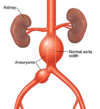Mod X: Anesthesia for Surgery of the Aorta Flashcards
Anesthesia for Surgery of the Aorta
OBJECTIVES:
- Identify the risk factors and causative factors of thoracoabdominal aneurysm development
- Familiarity with aneurysm and dissection classifications
- Discuss surgical treatment for thoracic aneurysm repair
- Discuss anesthetic management for thoracic aneurysm repair
- Discuss postoperative management of these patients
THORACOABDOMINAL AORTIC ANEURYSM
an enlargement of the aorta greater than or equal to 3.0 cm in diameter is the definition of:
Aneurysm

THORACOABDOMINAL AORTIC ANEURYSM
When was the First repair performed? what was the mortality rate at that time?
1951
(mortality rate was 20%)
THORACOABDOMINAL AORTIC ANEURYSM
What factors have contributed in the reduction in the mortality rate of THORACOABDOMINAL AORTIC ANEURYSM repairs to 2.5% today?
Improvements in surgical and anesthetic management
THORACOABDOMINAL AORTIC ANEURYSM
What’s the most important predictor of rupture of an aneurysm?
Size of aneurysm

THORACOABDOMINAL AORTIC ANEURYSM
Mortality rate of ruptured aneurysm is
85%

THORACOABDOMINAL ANEURYSM
most significant risk factor for developing a AAA is
Age

THORACOABDOMINAL ANEURYSM
Risk Factors for developing a THORACOABDOMINAL ANEURYSM in general include:
Age (most important risk factor)
Gender : Men > women; White males =most common
Smoking (hx of <0.5 ppd, for up to 10 yrs carries inc risk for AAA - This inc is dose dependent => smoking 1 ppd for 35 yrs has a 12-fold risk for AAA development - Smoking also inc the rate of aneurysm enlargement by 35%)
Increased salt intake - Sedentary lifestyle - HTN
Concomitant PAD and CVD - Diabetes
Family history of AAA (1st degree relatives of a pt w/ AAA have apprx 20% likelyhood for the dvpt of AAA)
Renal insufficiency
THORACOABDOMINAL ANEURYSM
Causative factors
Aortic aging and atherosclerosis = most common causative factors (80%)
Aortic dissection (17%)
Actual etiology unknown
THORACOABDOMINAL ANEURYSM
Rare causes:
Trauma
Mycotic infection
Syphilis
Takayasu arteritis
Marfan Syndrome
AORTIC DISSECTION
AORTIC DISSECTION is calssified depending on:
Extent of Aortic involvement
AORTIC DISSECTION
Classification systems
DEBAKEY CLASSFICIATIONS (Type I - Type III)
STANFORD CLASSIFICATION (Type A - Type B)

AORTIC DISSECTION - DEBAKEY CLASSFICIATIONS
Dissection from ascending aorta throughout entire aorta
Type I

AORTIC DISSECTION - DEBAKEY CLASSFICIATIONS
Dissection confined to ascending aorta
Type II

AORTIC DISSECTION - DEBAKEY CLASSFICIATIONS
Why are Type I and Type II dissection typically a/w aortic regurgitation?
Type I and Type II typically involve the aortic valve and cause aortic regurgitation

AORTIC DISSECTION - DEBAKEY CLASSFICIATIONS
Dissection that begins just distal to left subclavian artery and extend to diaphragm
Type IIIa

AORTIC DISSECTION - DEBAKEY CLASSFICIATIONS
Dissection that begins distal to left subclavian and extends pass the diaphragm, to the aortoiliac bifurcation
Type IIIb

AORTIC DISSECTION - STANFORD CLASSIFICATION
Dissection that involves the ascending aorta
Type A

AORTIC DISSECTION - STANFORD CLASSIFICATION
Dissection that does not involve ascending aorta
Type B

THORACOABDOMINAL ANEURYSM
Dilation of the descending aorta that extend into the abdominal aorta to the iliac arteries
THORACOABDOMINAL ANEURYSM

THORACOABDOMINAL ANEURYSM
Classification:
THORACOABDOMINAL ANEURYSMs were classified in 1983 by CRAWFORD (Type I through Type IV)

THORACOABDOMINAL ANEURYSM - CRAWFORD CLASSIFICATION
Aneurysm that extend from the origin of the left subclavian to suprarenal abdominal aorta
Type I

THORACOABDOMINAL ANEURYSM - CRAWFORD CLASSIFICATION
Aneurysm that extend from the subclavian artery to the aortoiliac bifurcation
Type II
This is the most extensive type of aneurysm!!!!

THORACOABDOMINAL ANEURYSM - CRAWFORD CLASSIFICATION
Aneurysm that extend from the distal thoracic aorta to the aortoiliac bifurcation
Type III














